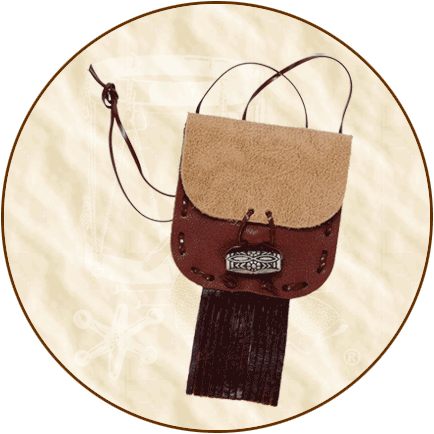.
Continued from product description on
Native American's Page Two...
Historical
Background: A medicine bag (or "medicine bundle,"
as it is sometimes called) is a container for items believed
to protect or give spiritual powers to its owner. Its size could
be small enough to wear around the neck or a large bag with a
long strap and carried like a "bandolier." The pouch
itself was usually made out of an animal skin. Sinew or rawhide
lace was usually used to sew the bag and be worn or hung. They
could be plain looking or richly decorated. Of course, the size
of the medicine pouch usually dictated what and how many "power
objects" could be placed in it.
Medicine pouches are worn, carried, or hung in (or near) the
home for many purposes and reasons. Past and present cultures
(or societies) had different uses and customs for their medicine
bags. One culture might have an elaborate ritual or ceremony
to "start" a medicine bag. Another culture might have
just a simple rule: Your medicine bag must be a gift from someone
else! A particular medicine pouch could even have its own set
of rules!
To some, medicine pouches are primarily used for protection
from real (seen) and spiritual (unseen) things. To others, their
bags have only a personal meaning (sentimental or beliefs). The
significance of this special pouch and it contents could either
be ordained (according to religious beliefs) or self-prescribed
(according to its owner's value system).
What went into a medicine pouch also varied greatly. The contents
of a medicine man's pouch would be quite different from a young
child's bag. Medicine pouches could be "made" for a
warrior with objects to enhance his fighting skills, for a farmer
who wanted a successful harvest, or for a mother who wanted her
family in good health. They could also be used to hinder enemies
and alter the weather. As you can see, the types of items that
went into a medicine pouch were up to the individual. Usually,
though, each object had some great meaning or was believed to
empower the wearer.
Power objects could be real or symbolic (personally or spiritually).
Herbs and roots could have real powers to make its owner physically
well again. Other objects could be used psychologically, such
as protecting oneself from negative thoughts or enhancing its
wearer with a positive attitude. Still, other objects could have
a deeply spiritual significance, such as getting helpful assistance
from supernatural powers. Today, many people have medicine pouches
containing charms or souvenirs. No matter what medicines go into
the pouch, the bag soon becomes an important and deeply personal
possession to its owner.
Medicine pouches predate recorded history. We know for a fact
they existed over 5,000 years ago after the 1991 discovery of
the "ice man" found in the Italian Alps with perfectly
preserved artifacts that included a medicine pouch. There is
also a suggestion that medicine pouches were used 8-10 thousand
years ago, according to the murals of Çatal Hüyük.
These murals depict vultures with human legs (representing shamans)
having ritual bags on their chests. Today, we know that medicine
pouches have been used throughout Man's societal history and
around the world.
Fun
Fact: Medicinal items attributed with supernatural powers
would often be procured by some North American Indians in a tribal
custom known as a "vision quest."
Fun
Fact: Dried Love Root was used in medicine pouches to
ward off evil people and spirits. It was believed that those
with Love Roots could discern the true intentions of others beyond
spoken words!
Fun
Fact: The African-American culture has a bag called a
"gris-gris." Because its pronunciation is similar to
a French word that translates into "grey-grey," some
believe it means "to encompass both white and black magic."
Others say gris-gris is more likely an Afro-French version of
the Central African word "gree-gree" (or "gri-gri").
The meaning of gree-gree is "fetish" or "charm,"
thus a gris-gris or gree-gree bag is a "charm bag."
In some societies, it is also referred to as a "mojo bag."
Fun
Fact: In the Caribbean, a bag of nearly identical African
derivative is called a "wanga bag" or "oanga bag"
(from the African word "wanga," which means "charm,"
but more closely translates as "spell").













